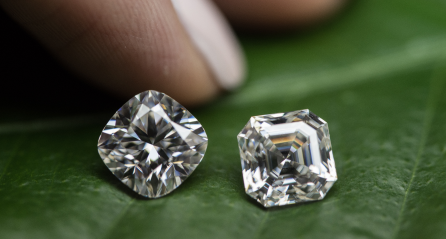Diamond selection checklist
How to choose a beautiful, high-quality diamond for a good price
With a lot of diamonds to select from, locating the one that is right for you may feel frustrating, particularly when compared to some jewelry shop where options are a lot more limited. Think about the following step-by-step guide for selecting your diamond. Everybody's diamond search is exclusive, however, you could find this to become a useful starting place. This guide will take 15 minutes to read and will give you a clear guideline when you want to buy a diamond online. We also added some tips for each of the 4C's to save on your budget when you actually buying your diamond.
In this guide you will discover :
- A step by step guide on how to select a loose diamond
- Advice on how to buy a quality diamond
- Diamond Cut buying tips
- Diamond Carat size buying tips
- Diamond Color buying tips
- Fluorescence , why it matters
- Diamond Clarity buying tips
- Diamond Certification buying tips
- Bottom line
Step-by-step guide : how to choose and buy a beautiful diamond
1. First, determine the diamond shape preferred by the recipient. If you don't know and can't discover, consider a round or princess cut.
2. Set a carat weight minimum based on the individual's preferences. When they have their heart set on a one carat diamond, even one of the most beautiful half carat diamonds will be a disappointment.
3. Begin with the greatest quality diamond of the shape and carat weight you selected in steps 1 and 2, and start making concessions so that you get to a diamond that meets your budget:
- First, reduce the clarity. See clarity purchasing tips (below) for more information. Reduce to VS2 prior to making concessions in other areas.
- Next, reduce the Color. View color purchasing tips (below) for more information. Reduce to H prior to making concessions in the other areas.
- Finally, reduce the Cut. View cut purchasing tips (below) for more assistance. Reduce to very good in round diamonds, and good in other shapes prior to making concessions in the other areas.
When the diamonds that fits your revised requirements is near your budget, consider shaving off some carat weight to be able to close the gap. A carat weight variation of 10% or less is going to be very hard to detect visually.
4. If after following the steps above, you're still outside your budget, repeat the procedure with new thresholds:
- First, further reduce clarity. Reduce to as little as SI1
- Next, reduce Color. Reduce to as little as I. Knowing the diamond is likely to be set in gold, you can properly drop it to E.
- Finally, decrease the Cut. Reduce to very good in round diamonds, and good in fancy shapes.
5. If you are still well outside your budget, you might need to think about upping your budget or lowering your minimum carat weight goal.
To help you find the right diamond within your budget: contact us directly to speak to our diamond experts
Further advice on how to buy a quality diamond
Below information is a summary of our advice found in our diamond buying guide and in several articles on our site.
Diamond cut purchase tips
Cut grade may be the most important factor in determining the entire appearance of a diamond because a poorly cut diamond may look boring in spite of superb clarity and color. However, a properly cut diamond may have a somewhat lower color (G-H) or clarity (SI1) and still appear really beautiful, because of its superior ability to create sparkle and brilliance.
For superior brilliance, select a diamond having a cut grade of Very Good or Excellent for round diamonds, and good or better in fancy shape diamonds. When choosing a diamond within this selection, make sure its symmetry and polish Are very Good or Excellent, so the effect of the above average Cut isn't obscured.
For those on a budget, mainly worried about size, a diamond of Fair - Good cut may be a satisfactory option, especially in fancy shapes. As the diamond will lack the beauty of a properly cut diamond, it will offer a big increase in size for the same price.
Diamond carat weight purchase tips
Try to find diamonds that fall just under common carat weights for example 0.5ct., 0.75 ct., 1 ct., etc. Because these diamonds fall just shy of the most popular weight, they're generally offered at a small discount compared to diamonds of full weight. Like, a .90 carat diamond can generally cost-less on the value-per-carat basis when compared to a whole 1.00 carat diamond. Visually, they're difficult to tell apart. In fact, a smaller carat weight diamond might have a size equal to that of a heavier diamond, which makes it look the same size when viewed from above. The most popular carat weights for diamonds are between one and two carats. If your diamond falls under.75 carats due to a budget necessity, look at a marquise cut, which appears bigger than other styles of equal carat weight, because of the elongated cut.
Diamond color purchase tips
The vast majority of untrained observers (and lots of gemologists) can't identify a color quality from the one just above or below until the diamonds are compared next to each other in a controlled environment. Even then, changes in color are difficult to detect in I color and higher diamonds.
Color becomes much harder to detect once a diamond is set in a ring and put into an environment that contains color (instead of the all-white background used in color grading). For instance, an H color diamond might look as clear as being a D when set in a ring under normal lighting conditions, particularly when both are not compared next to each other.
To discover the best price in what would seem to the naked eye as a colorless diamond, look for G-I diamonds. Since color is simpler to discover in larger diamonds, go for G-H in diamonds more than 1 carat. Once set in a ring, these diamonds will appear the same as better color grade diamonds. Instead of buying better color, spend money on a better cut, the main factor in a diamond's brilliance.
Since diamonds with more facets reflect more lighting, they tend to hide color better than other styles. So, consider round or princess cuts should you be concerned with color.
Fluorescence: does it matter?
Colorless (D-F) fluorescent diamonds sell in a 5-15% discount to non-fluorescent diamonds because the fluorescence is perceived as a defect. Actually, the obvious effects of faint to medium fluorescence are noticeable only to a gemologist using a particular UV light source.
In General, fluorescence should not become a significant aspect in the diamond purchase since its effects on appearance are negligible, if not slightly positive. The exception should be to exercise caution in purchasing a diamond with strong or very strong fluorescence in D-H color diamonds (which don't have enough yellow color to offset the blue fluorescence).
Diamond clarity purchase tips
If you cannot tolerate imperfections, even those you can't view, choose a VS1 or better diamond. About 10% of most diamonds sold fall into this category.
The most used range is the VS1 VS2 diamond. These diamonds look flawless to the naked eye, and are a fraction of the price of an exquisite diamond. Almost 50% of all diamonds acquired fall under this range.
The following most popular variety is SI1, where the blemishes usually are not significant enough to influence the appearance of the diamond for the casual observer. Generally, consumers choose for this clarity range in exchange for a bigger cut or color quality. This combination typically results in a lovely, lively diamond with flaws detectable only upon close inspection.
If you are mainly focused on size and cost, I1 could be your best clarity solution. While the inclusions are apparent for the unaided eye, many shoppers believe it is worth it the sacrifice for what it returns in size.
The bigger the diamond, the easier imperfections are recognized; therefore Clarity becomes more important. For diamonds over 2 carats, a clarity grade of VS2 or higher will be the safest choice for preventing any signs of visible inclusions. In diamonds between 1 and 2 carats, clarity grades of SI1 or better won't have inclusions easily visible to the naked eye. In diamonds under 1 carat, clarity should be the least considered of the traditional 4 Cs.
Diamond certification purchase tips
All Labs are not created equal, and their certification is not held to any objective standard. Unfortunately, some labs have succumbed to pressure from shops to lessen their criteria, thereby allowing lower quality diamonds to be given higher ratings, raising their price available on the market. Before depending on any certification, be sure you are more comfortable with the reputation and expertise of its author.
We have chosen to provide only GIA , IGI and HRD certified diamonds,
Be careful when you compare the price of diamonds graded by two different labs; what at first appears like a deal may only be the consequence of more stimulating grading.
Simply buy diamonds which were certified by a reputable lab. Do not trust certifications produced by retailers, even if they claim to be GIA trained.
Keep your certificate in a safe place. It gives invaluable safety in the event of loss or resale. When the diamond should leave your control (for instance, to be cleaned), make sure to let the company taking control know you have a certificate. Knowing you can identify your diamond removes any temptation of the 3rd party to commit fraud .
The bottom line
We understand buying a diamond can be a complex and difficult task. Especially when you are doing it only once in your life. That is why we created this checklist and added quick tips so even with limited knowledge you can also buy a high-quality diamond on our site. Off course, our diamond experts are always there to help you via a personal and professional consultation to find your perfect diamond. We offer assistance online, via phone or even in our offices in a secure and relaxed environment.








